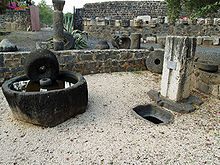The city of Villajoyosa had its first settlers in the bronze age. The hill where the old town is was an ancient Iberian settlement.
.jpg)
The city "Alone", "Allon" or "Alonis" obtained the title of Municipium from the Roman emperor Vespasiano in 74 A.D interestingly there were only 10 roman cities in the Valencian Community.
From the time of Emperor Nero´s rule and between the years 64-68 A.D, is the "Bou Ferrer" a Roman merchant ship wrecked off the coast of Villajoyosa. It was a 30 m trade sailboat carrying about 2500 amphorae produced pottery, each containing about forty liters of liquid fish sauce produced from anchovy, mackerel and horse mackerel guts called "garum". It probably carried olive oil and "mulsum" a spiced wine for the sailors´ daily use.
The amphoras were placed between olive vine shoots for protection during transport. The ship carried also 12 ingots of lead weighting each 64 kg with the countermark "Imperor Germanic Augustus"
In the centre of the town a bath house was also discovered as well as the remains of a military camp were a Cohort (500 roman soldiers) lived during the Sertorian Wars (Roman civil wars) in 75 B.C, during which, Iberians and Romans fought together.
In the centre of the town a bath house was also discovered as well as the remains of a military camp were a Cohort (500 roman soldiers) lived during the Sertorian Wars (Roman civil wars) in 75 B.C, during which, Iberians and Romans fought together.

It is in the II century A.D during the Roman occupation that the "Hercules Tower" was built in what was then the Hispania Tarraconensis. Originally it was crowned by a pyramidium.

Evidence of this occupation are found in the Tossal, Mosque and Necropolis (burial site or cemetery) of l´Almisserà, Foietes d´Alt and Alfarella.

In 1.300 Bernardo de Sarria, the Admiral of James II of Aragon founded la "Vila Nova Cristiana" with the strategic objective of controlling the coast against the Islamic attacks.
In 1443 Villajoyosa got the privilege of a real city.
During the sixteenth century Villajoyosa played an important role in the defense of the coast against the numerous attacks by Berber pirates and corsairs like "Khayr ad-Din Barbarus" "Barbarossa Hayreddin Pasha" known as Barbarroja.



For this reason King Philip II ordered the construction of new walls around the city. The "Asunción church" dating from the XVI century, is one of the three fortress-churches of the Province of Alicante, built in a Gothic-Levantine style.
 As part of the defensive system there were guard towers along the coast and many in the countryside like the "Xarco" tower.
As part of the defensive system there were guard towers along the coast and many in the countryside like the "Xarco" tower.


In the late seventeenth century, pirates stopped attacking, permitting urban growth outside the fortified walls.
Around this time started growing the 1400 year old Monumental Tree known as "Olivera Grossa" It´s 7,50 meters high, it has a trunk perimeter of 1,30mts around the base and a tree crown diameter of 11,50.

During the 19th century due to trade relations with Ecuador and Venezuela, cocoa and the chocolate industry became very importance for Villajoyosa.
In 1911 Alfonso XIII gave it the title of city.
In 1443 Villajoyosa got the privilege of a real city.
During the sixteenth century Villajoyosa played an important role in the defense of the coast against the numerous attacks by Berber pirates and corsairs like "Khayr ad-Din Barbarus" "Barbarossa Hayreddin Pasha" known as Barbarroja.

"Dragut" or "Turgut Reis"
Sahah Rais

Another still present is the Aguiló Tower, built between 1525-1550 with the Renaissance system of a square floor, one of the best preserved of Spain.
Around this time started growing the 1400 year old Monumental Tree known as "Olivera Grossa" It´s 7,50 meters high, it has a trunk perimeter of 1,30mts around the base and a tree crown diameter of 11,50.
In 1911 Alfonso XIII gave it the title of city.


